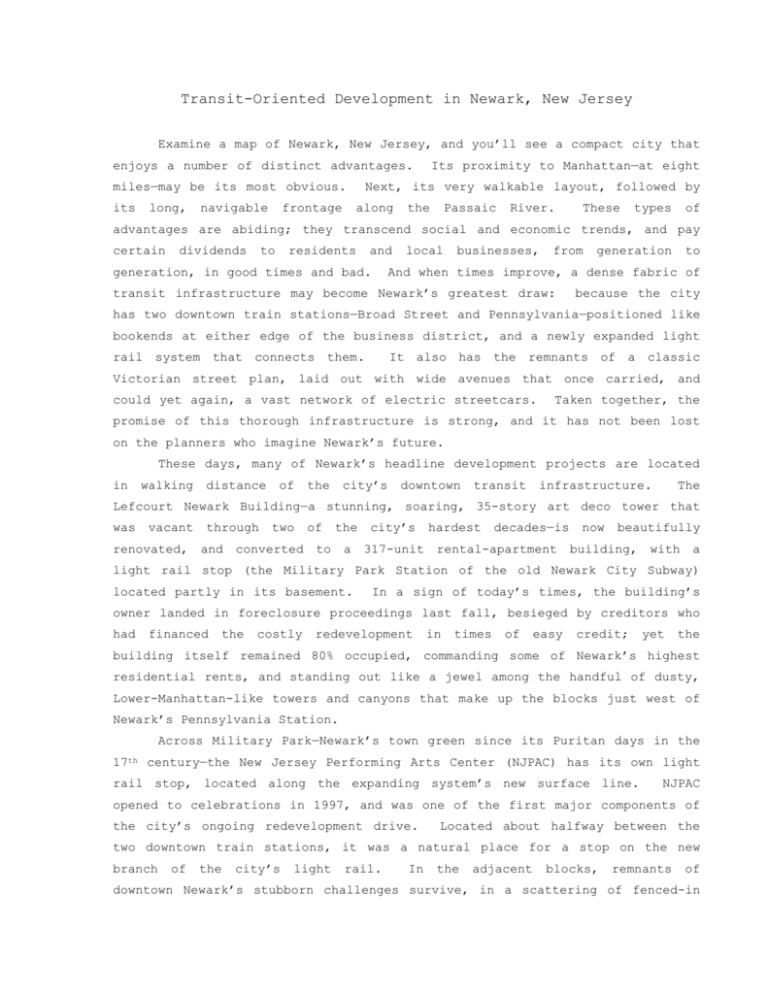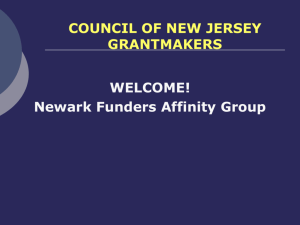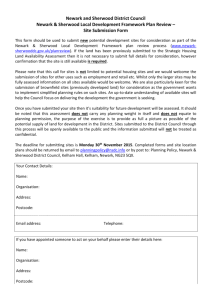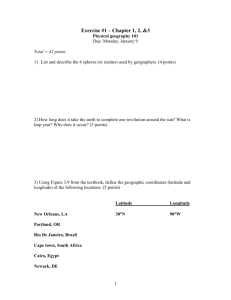Transit-Oriented Development in Newark, New Jersey
advertisement

Transit-Oriented Development in Newark, New Jersey Examine a map of Newark, New Jersey, and you’ll see a compact city that enjoys a number of distinct advantages. miles—may be its most obvious. its long, navigable frontage Its proximity to Manhattan—at eight Next, its very walkable layout, followed by along the Passaic River. These types of advantages are abiding; they transcend social and economic trends, and pay certain dividends to residents and generation, in good times and bad. local businesses, from generation to And when times improve, a dense fabric of transit infrastructure may become Newark’s greatest draw: because the city has two downtown train stations—Broad Street and Pennsylvania—positioned like bookends at either edge of the business district, and a newly expanded light rail system that connects them. It also has the remnants of a classic Victorian street plan, laid out with wide avenues that once carried, and could yet again, a vast network of electric streetcars. Taken together, the promise of this thorough infrastructure is strong, and it has not been lost on the planners who imagine Newark’s future. These days, many of Newark’s headline development projects are located in walking distance of the city’s downtown transit infrastructure. The Lefcourt Newark Building—a stunning, soaring, 35-story art deco tower that was vacant renovated, through and two converted of the city’s a 317-unit to hardest decades—is rental-apartment now beautifully building, with a light rail stop (the Military Park Station of the old Newark City Subway) located partly in its basement. In a sign of today’s times, the building’s owner landed in foreclosure proceedings last fall, besieged by creditors who had financed the costly redevelopment in times of easy credit; yet the building itself remained 80% occupied, commanding some of Newark’s highest residential rents, and standing out like a jewel among the handful of dusty, Lower-Manhattan-like towers and canyons that make up the blocks just west of Newark’s Pennsylvania Station. Across Military Park—Newark’s town green since its Puritan days in the 17th century—the New Jersey Performing Arts Center (NJPAC) has its own light rail stop, located along the expanding system’s new surface line. NJPAC opened to celebrations in 1997, and was one of the first major components of the city’s ongoing redevelopment drive. Located about halfway between the two downtown train stations, it was a natural place for a stop on the new branch of the city’s light rail. In the adjacent blocks, remnants of downtown Newark’s stubborn challenges survive, in a scattering of fenced-in parking lots and disused buildings. But after more than a decade of its own success, the home of the New Jersey Symphony Orchestra now appears to be serving its envisioned role as a springboard for major, adjacent development projects. This part of downtown Newark is coming together; you can feel it. And highlighting investor confidence in the area’s residential real estate market are two major projects that have recently been announced near NJPAC: One Rector Street, a 25-story, mixed-use building that will include 152 condominiums and 6,000 square feet of retail space; and a 44-story tower at Two Center Street, expected to become the city’s tallest building, with 328 rental apartments, and more than 22,000 square feet of commercial space. It is not surprising that the first, tepid steps of market-rate, residential developers into this once-overlooked city have been downtown. The city’s transit connections are concentrated here, and the area’s lower land costs, when compared to Hoboken or Jersey City, provide an enticing development opportunity. The area is also home to a number of its own points of interest, including NJPAC, the Newark Museum, a high concentration of office space, and the Rutgers and N.J.I.T. campuses (though, technically, these latter blocks are often called University Heights). Building on this foundation, in 2008, the city published a redevelopment plan for the blocks around Broad Street Station, located at downtown’s northern edge. Perris Straughter, a senior planner at the Newark City Hall, played a lead role in the project, which was drafted in consultation with the architectural firm of Skidmore Owings and Merrill. redeveloping the Area, Straughter described a multifaceted approach to combining plans for numerous parcels ownership, and drawing broadly on a number of T.O.D. principles. with diverse Traditional post-war parking requirements have been relaxed for new developments in the blocks around transit facilities; densities have been increased; mixed uses are now encouraged; and the needs of pedestrians are prioritized. One of the earliest phases of implementation is the ongoing demolition of the once-notorious Baxter Terrace housing project, a low-rise development which formerly occupied a semi-rectangular parcel on the western edge of downtown, bounded by Sussex Avenue, Nesbitt Street, Orange Street, and the backyards of buildings on Dr. M.L.K. Boulevard. for construction of medium-density, mixed In its place, the plan calls use development, including a significant component of affordable housing units, as well as market-rate housing. When finished, the development will reconnect the blocks along the east side of Olmsted’s Branch Brook Park (including Ludwig Mies van der Rohe’s 1960 glass and aluminum Colonnade apartments and the limestone gothic Cathedral Basilica of the Sacred Heart), with the University neighborhood (including the campuses of Rutgers and N.J.I.T.). Heights Theoretically, the successful redevelopment of the Baxter Terrace site could weave into existence a seamless urban fabric between the city’s central business and academic districts and its significant stock of large, attractive homes in the North Ward. Such thoughts point to a more distant horizon. If experience is any guide, it could be a decade or longer before the development potential of downtown Newark begins to approach build-out. In addition to the major parcels that remain undeveloped, the central business district includes a generous scattering of surface parking, vacant lots, disused industrial sites, and other types of neglected or underutilized parcels. But a number of the city’s other neighborhoods are already quite vibrant, and potentially in need of new spaces. Addressing the development needs of such communities could prove to be prescient. Darius Sollohub, an architect and assistant professor at Architecture NJIT’s reweaving College a of network thoroughfares. of mass and Design, transit is through particularly the city’s keen on principal Presently, NJ Transit operates a light version of Bus Rapid Transit (BRT) on two of the city’s major arterials—Bloomfield and Springfield Avenues—known as the Go Bus. These routes lead out through the city’s low- rise neighborhoods, west of downtown, where residents have been underserved (or un-served) by rail since the Public Service streetcars disappeared in the early 1950s. The Go Buses are distinguished from the ordinary NJ Transit fleet by their distinctive color scheme, improved seating, fixed and limited stops, and the promise of faster service. Essentially, BRT seeks to capture a number of the benefits of light rail or streetcar service at a fraction of the cost. As the director of NJIT’s graduate program in Infrastructure Planning, Sollohub has been conducting a study of BRT usage along the city’s Springfield Avenue corridor, where he has found heavy demand for the service. Partly as a result of the study’s findings, Sollohub is also involved in ongoing discussions with community leaders and private developers about the possibilities for T.O.D. style development. historic heart of the city’s One potential site lies at the Springfield-Belmont neighborhood: a parcel adjacent to the busy Go Bus stop, where Springfield Avenue crosses Irvine Turner Boulevard. Discussions have included strategies for balancing the T.O.D. design and density priorities with the parking and traffic needs of potential anchor stores. In the North Ward, the oldest part of the city’s through a deep cut which was once the Morris Canal. light rail runs The City Subway, as it was long known, channeled surface streetcars into the shallow canal bed, and led them to a tunnel that ran beneath Raymond Boulevard to Pennsylvania Station. Today, the light rail makes surface stops every few blocks between NJIT in University Heights, and the city’s distant northern boundary with Bloomfield Township. Just east of the right-of-way is the large, landscaped expanse of Branch Brook Park; to the west are mostly the backs of low-rise industrial buildings that once lined the canal, before its abandonment in the depths of the Great Depression. It is interesting to imagine how some of these from parcels—so long divorced their practical location beside a functioning waterway—might one day be repurposed, given their proximity to both the newly modernized light rail and an immense, Olmsted-designed green space. Perris Straughter, senior planner at City Hall, is already thinking about it. Downtown Newark, with its blocks set off by two major train stations, could be seen as an organic example of T.O.D. The assortment of development projects that draw on proximity to the transit infrastructure is not new. Rather, it is the rediscovery of value in a pattern that has characterized the neighborhood for at least two centuries—a place where, even before the railroads, traffic on the Morris Canal and Passaic River spurred development in these same blocks. neighborhoods is Meanwhile, the T.O.D. potential of Newark’s other noteworthy, particularly for land that lies in distance of the city’s light rail and early BRT infrastructure. coming years, as the benefits of sustainable, urban walking In the environments are rediscovered, it will be increasingly difficult to ignore the inherent value of Newark’s infrastructure, where many of the building blocks of sustainable communities are already thoroughly established. Theo Mackey Pollack is a graduate student at Rutgers University, and a 2010 N.J.D.C.A./Wells Fargo Housing and Community Development Scholar, with a placement in the City of Newark’s Department of Economic and Housing Development.






